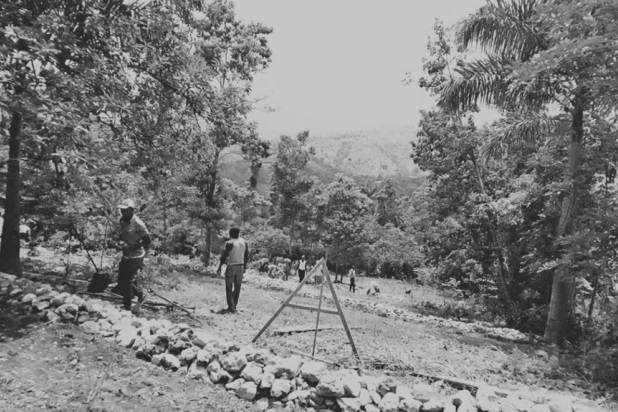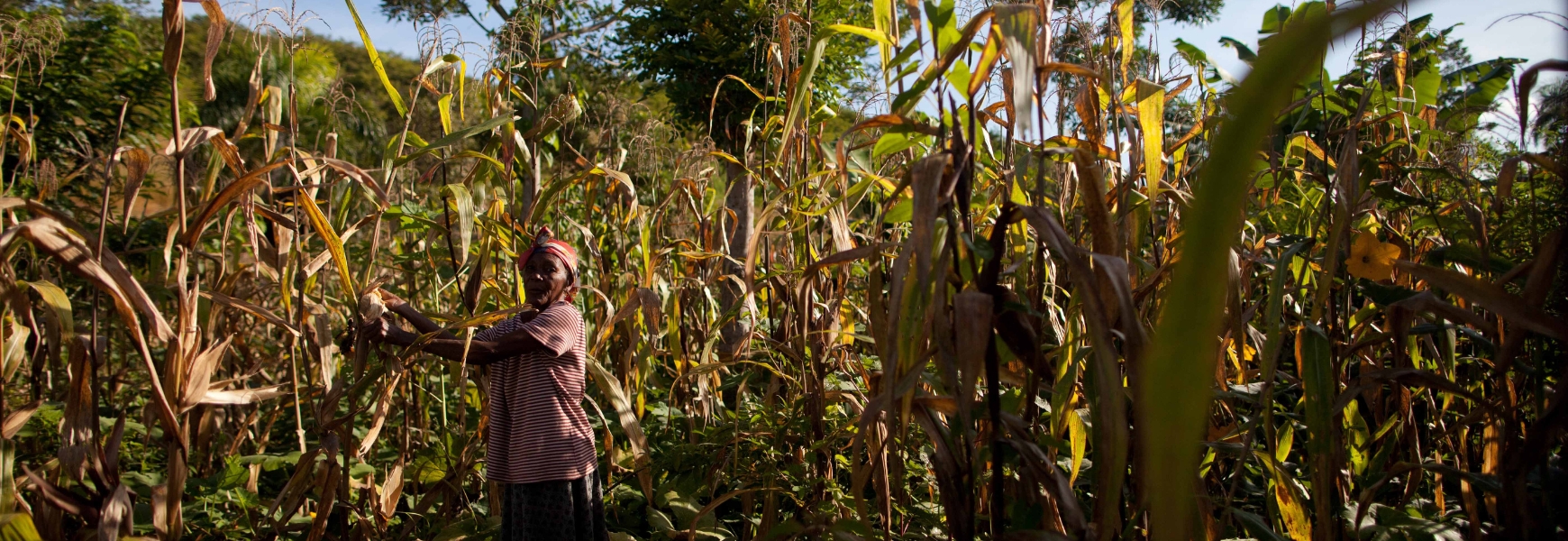How to Build a Model Farm through Agroecological Farming: A Practical Guide
Across the globe, farmers are confronting a storm of interwoven crises. Climate change, shifting global social dynamics, and systemic injustices intersect with soil degradation, prolonged droughts, economic instability, and rising insecurity. For rural communities, building sustainable food systems—where both people and ecosystems can thrive—is not just an aspiration, but a necessity for survival and dignity. And this matter affects us all. Smallholder farmers produce up to 80% of the world’s food. Without their knowledge, labor, and resilience, our shared future is at risk.
The Practical Guide to Creating an Agroecological Farm can help respond to these urgent challenges. Developed by the Haitian NGO Partenariat pour le Développement Local (PDL) in collaboration with Groundswell International, the guide distills more than a decade of agroecological practice in Haiti into a practical, adaptable framework for developing agroecological model farms.
While rooted in the Haitian context, its principles and practices are relevant far beyond. Many of Groundswell International’s partners across Latin America, West Africa, and South Asia are already applying similar approaches to strengthen community-led farming systems. This guide aims to share those learnings more widely, whether you are a member of an agroecology network, an NGO practitioner, a farmer seeking more sustainable practices, or a facilitator supporting farmer-to-farmer learning.

Model farming: agroecology as the way forward
The guide emerges at a critical time. We need farming systems that restore degraded landscapes, reduce dependence on external inputs, provide healthy food, and generate reliable sources of income. This guide offers a field-tested methodology for achieving these goals through a process that strengthens farmer agency and prioritizes local knowledge.
Rather than prescribing a one-size-fits-all approach, the guide presents a flexible set of agroecological practices—what PDL refers to as a “basket of options“. These practices have demonstrated measurable outcomes: improved soil fertility, higher yields, greater food security, stronger community collaboration, and increased household income. The focus is not only on productivity, but also on the co-creation of knowledge, where farmers are central actors in transforming their food systems.
What is a model farm?
A model farm, as defined by PDL and Groundswell International, is an agricultural plot that is developed and maintained by farmers who apply agroecological principles. These farms are not static demonstrations but dynamic, evolving learning spaces. Model farms serve as both sources of diversified, sustainable food production and platforms for peer-to-peer learning within the community.
Model farms play a central role in scaling up agroecological farming. They help spread knowledge and build networks of practice through direct experience. The approach reflects a broader understanding of sustainable agriculture as a process embedded in farmer-led innovation, driven by observation, experimentation, and adaptation to local realities.
The importance of model farms in scaling agroecology
Model farms serve as both social and ecological hubs—spaces where agroecological practices come to life. They inspire farmers to adopt approaches that strengthen their livelihoods, regenerate natural resources, and provide healthy food for their communities. Unlike conventional farms, model farms demonstrate practical pathways toward farming systems that benefit farmers, ecosystems, and consumers alike.
Their relevance extends across diverse regions, as their core principles can be adapted to fit different environmental, social, and economic contexts. Agroecological model farms matter because they:
- Boost productivity and income: By implementing multiple, synergistic practices, farmers can increase yields and diversify their income sources.
- Strengthen food sovereignty: By diversifying what they grow and producing food across different seasons, farming households are better able to meet their own needs year-round and are less vulnerable to seasonal hunger. Agroecological model farms help communities regain control over what they grow, how they grow it, and for whom, reducing dependence on volatile global markets, imported food, and corporate supply chains.
- Build climate resilience: Agroecological practices—such as mulching, tree planting, and soil conservation—help mitigate the impacts of drought and extreme weather.
- Enable knowledge transfer: Model farms serve as real-life examples that others can visit, learn from, and replicate, accelerating community-level change.
- Regenerate ecosystems: Through diversified, organic farming methods, these farms help restore soil health, rebuild biodiversity, and revitalize degraded landscapes.

How to build a model farm: a practical guide for NGO program staff, farmers, and agroecology facilitators
The guide outlines the process of building a model farm through clear, actionable steps, beginning with foundational practices like soil and water conservation, and progressing to diversified cropping, natural pest management, and collective organization. Each practice is illustrated with step-by-step instructions, enabling agroecological farmers, those new to agroecology, facilitators, and NGO program staff to adopt and adapt practical techniques to strengthen or initiate their agroecological efforts.
Soil and water conservation
In mountainous or erosion-prone landscapes, conserving topsoil is critical. The guide provides simple, low-cost techniques, like using an A-frame level constructed from sticks and string to trace contour lines. Farmers then build barriers using stone, straw, or local vegetation to prevent runoff and retain moisture. These techniques are applicable beyond the Haitian context, as they are designed to be replicable using local materials and require minimal external inputs.


A training on building an A-frame level
Seed selection and conservation
Selecting resilient, locally adapted seeds is central to long-term productivity. The guide walks through simple germination tests and offers methods for community-level seed exchange, enabling farmers to preserve and strengthen genetic diversity in their fields.
Crop diversification and agroforestry
Model farms are designed to produce food year-round. The guide emphasizes intercropping, crop rotation, and the integration of fruit trees and nitrogen-fixing species to restore biodiversity and support soil health. These practices increase yields and reduce vulnerability to climatic and market shocks.
Natural pest and disease management
Rather than relying on expensive or harmful agrochemicals, the guide outlines techniques that use available ingredients, such as ash, garlic, hot pepper, or neem leaves, to manage pests and diseases. These methods reduce production costs while protecting human and environmental health.
Collective action: The role of Gwoupman and Kombit in building model farms
Beyond individual practices, the guide emphasizes the importance of collective organization. In Haiti, farmer groups known as Gwoupman play a critical role in mutual support and knowledge sharing. These groups provide structure for collaborative labor, shared experimentation, and the scaling of agroecological practices from the ground up.
One member described their group as “a development model for the community”—a statement that reflects the practical function of these collectives and their deeper social and cultural significance. The practice of Kombit, or collective labor, is a long-standing Haitian tradition that aligns closely with the values of agroecology: cooperation, solidarity, and shared responsibility.

Who is this guide for?
This guide is a resource for a wide range of practitioners and stakeholders working toward agroecological transitions:
- Agricultural Support Organizations: Especially those in the Haiti Food Systems Alliance (HFSA) and agroecology networks. These institutions can use the guide to strengthen community-based agricultural development strategies.
- Agricultural Professionals: Agronomists, technicians, and farmer educators will find practical tools and frameworks to design and deliver effective training programs. The content is grounded yet adaptable for various environmental and cultural contexts.
- Farmers and Farmer Organizations: The guide is also accessible to farmers seeking to improve their practices and transition to regenerative and agroecological farming, whether independently or in collaboration with peers.
- Researchers and Field Practitioners: Those already engaged in agroecological farming or sustainable development will find this guide to be a credible, experience-based contribution to ongoing efforts in knowledge generation and application.
A clear, proven path forward
At its core, the Practical Guide to Creating an Agroecological Farm is about reclaiming power: power for farmers to steward their land with knowledge and purpose; power for communities to organize and build more resilient futures; and power for organizations to support agroecological transitions that are grounded in local realities.
It does not promise quick fixes. Instead, it offers a field-tested roadmap built from years of collaboration, experimentation, learning, and collective wisdom.
“This guide honors the knowledge and lived experience of Haitian smallholder farmers. It’s not a recipe to follow, but a flexible, context-driven tool designed to support the agroecology movement in Haiti and beyond. It encourages co-creation, adaptation, and collective learning between farmers and practitioners. More than just a training manual, it’s a pathway toward resilience, ecological restoration, and farmer-led transformation of our food systems.”
Ronel Lefranc, one of the authors of “A Practical Guide to Creating an Agroecological Farm”, and Groundswell International’s Haiti Regional Coordinator

Download the Practical Guide to Creating an Agroecological Farm
and apply learnings to your own context!

